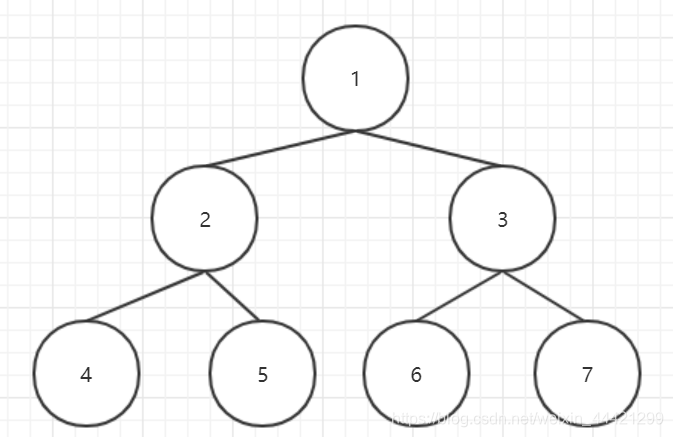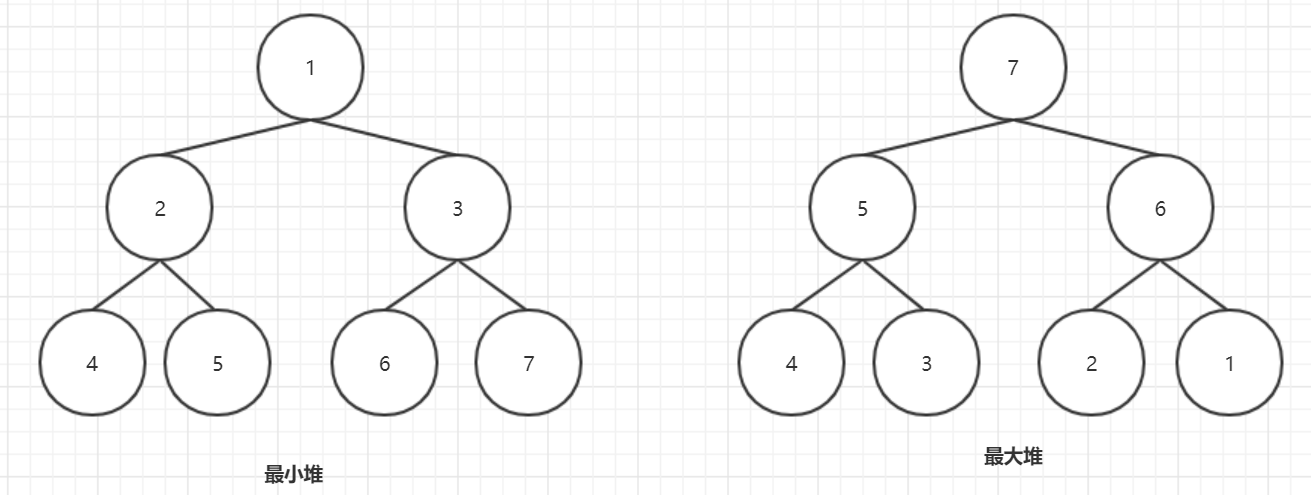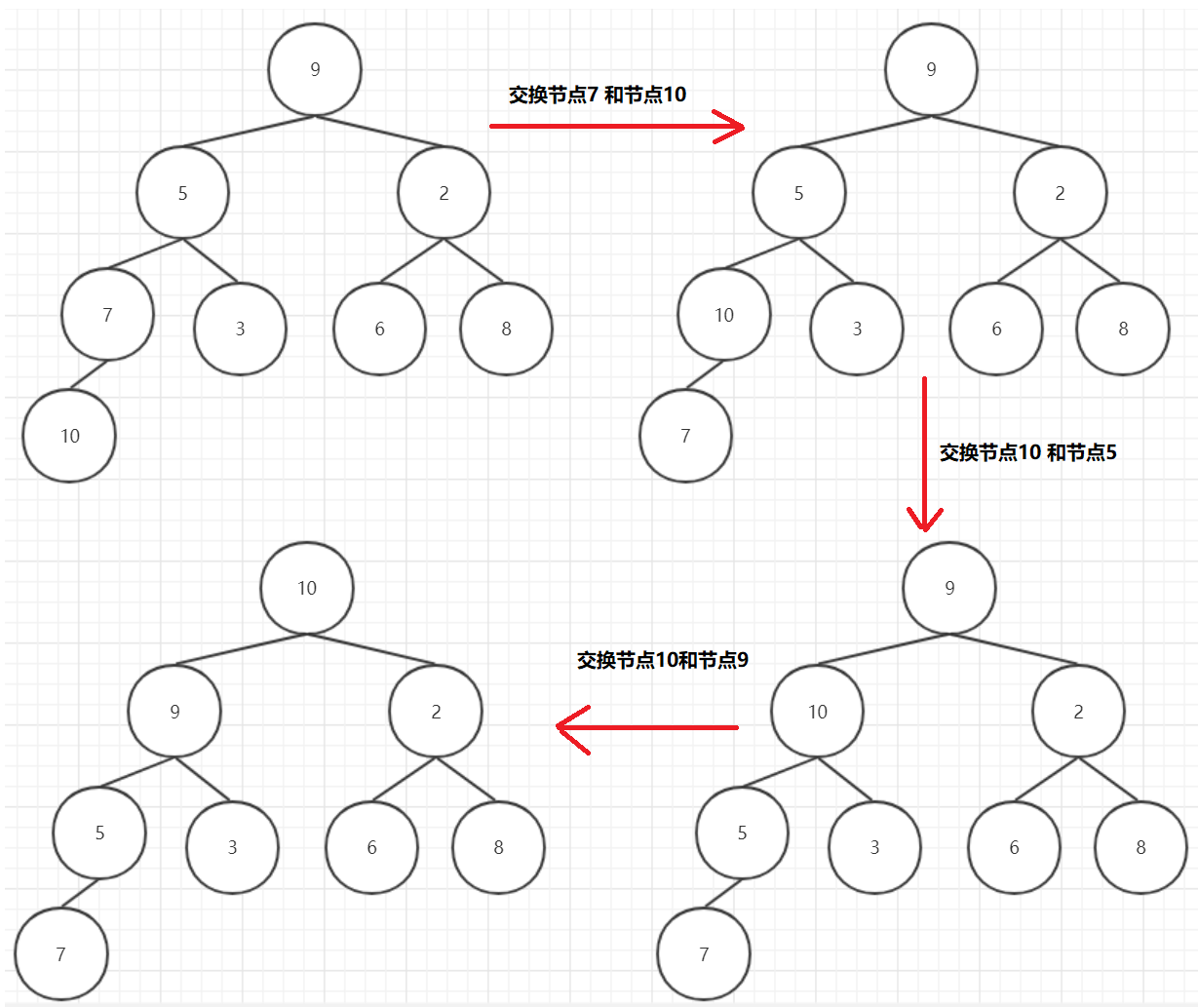堆
由于堆的存储使用到了数组的存储二叉树的方式,所以我们先介绍二叉树的顺序存储
1. 二叉树的顺序存储
1.1 存储方式
使用数组保存二叉树结构,即将二叉树用层序遍历方式放入数组中。
一般只适合表示完全二叉树,因为非完全二叉树会有空间的浪费。
这种方式的主要用法就是堆的表示。

如上图,其顺序存储的结果为:
1.2 数组中的下标关系
通过观察上面的例子,我么可以发现
- 父节点(parent)的数组下标=(孩子节点(child)下标-1)/2
例:父节点 2 的 下标为1 ,其左孩子 4 的下标 (3-1)/2 = 1 其右孩子 5 的下标 (4-1)/2 = 1
- 左孩子节点下标=父节点下标*2+1
例:父节点3 下标为2 ,其左孩子6的下标为5 2*2+1=5
- 右孩子节点下标=父节点下标*2+1
例:父节点3 下标为2 ,其右孩子7的下标为6 2*2+2=5
2. 堆的概念
**堆是一种满足以下条件的树:**堆中的每一个节点值都大于等于(或小于等于)子树中所有节点的值。或者说,任意一个节点的值都大于等于(或小于等于)所有子节点的值。
-
堆逻辑上是一棵完全二叉树
-
堆物理上是保存在数组中
-
满足任意结点的值都大于其子树中结点的值,叫做大堆,或者大根堆,或者最大堆
-
反之,则是小堆,或者小根堆,或者最小堆
-
堆的基本作用是,快速找集合中的最值

最大堆总是将其中的最大值存放在树的根节点。而对于最小堆,根节点中的元素总是树中的最小值。堆属性非常有用,因为堆常常被当做优先队列使用,因为可以快速地访问到“最重要”的元素。
3. 堆的操作
**前提:**左右子树必须已经是一个堆,才能堆化。
3.1向下堆化(以构建小根堆为例)
如果我们要将 节点9 调整到正确的位置,首先应该找到其左右孩子的较小值( 节点2 ),将其与 节点9 调换位置,接着以交换后的新位置为根节点再次判断调整,找到其左右孩子的较小值( 节点6 ),将其与 节点9 调换位置,最终结果如下图所示

代码如下
/**
* 向下调整堆 (小根堆)
* @param array 堆元素数组
* @param size 通过size指定array数组中哪些元素是有效堆元素
* @param index 从哪个位置开始调整
*/
public static void shiftDown(int[] array, int size, int index)
{
int parent = index;
int child = 2 * parent + 1;//左子树下标
while (child < size)
{
//比较左右子树,找到较小值
if (child + 1 < size && array[child + 1] < array[child])
{
child = child + 1;
}
//将child与parent比较
if (array[child] < array[parent])
{
//如果父节点大于子节点,交换其位置
int temp = array[child];
array[child] = array[parent];
array[parent] = temp;
}
else
{
//无需调整
break;
}
//更新
parent = child;
child = parent * 2 + 1;
}
}
3.2 向上堆化(以构建大根堆为例)
如果我们要将 **节点10 ** 调整到正确的位置,判断其 父节点7 与它的大小,如果其大于父节点值,则交换两个节点,交换后以的新位置为孩子节点依次判断调整,具体步骤如下图所示

代码
/**
* 向上建堆(大顶堆)
* @param array
* @param index
*/
public static void shiftUp(int array[], int index)
{
int child = index;
int parent = (index - 1) / 2;//父节点为 (孩子节点下标位置-1) /2
while (child > 0)
{
//将child与parent比较,如果孩子节点大于父节点,则交换位置
if (array[child] > array[parent])
{
int temp = array[child];
array[child] = array[parent];
array[parent] = temp;
}
else
{
break;
}
//当前父节点位置作为新的孩子节点,递归下次
child = parent;
parent = (child - 1) / 2;
}
}
4. 优先队列
4.1 定义
普通的队列是一种先进先出的数据结构,元素在队列尾追加,而从队列头删除。在优先队列中,元素被赋予优先级。当访问元素时,具有最高优先级的元素最先删除。优先队列具有最高级先出 (first in, largest out)的行为特征。通常采用堆数据结构来实现。
4.2 实现
通过上面对堆的学习,我们发现构建堆后 可以快速地访问到**“最重要”**的元素 ,所以我们用其来实现优先队列。
- 在入队列时,使用向上堆化
- 在出队列时,用最后一个元素覆盖第堆顶元素,再使用向下堆化
public class MypPriorityQueue
{
//存储堆(二叉树)的数组
private int array[] = new int[100];
//当前队列中的元素个数
private int size = 0;
/**
* 测试方法
* @param args
*/
public static void main(String[] args)
{
MypPriorityQueue queue = new MypPriorityQueue();
queue.offer(9);
queue.offer(5);
queue.offer(2);
queue.offer(7);
queue.offer(3);
queue.offer(6);
queue.offer(8);
for (int i = 0; i < 7; i++)
{
System.out.println(queue.poll());
}
}
/**
* 向上建堆(大顶堆)
* @param array
* @param index
*/
public void shiftUp(int array[], int index)
{
int child = index;
int parent = (index - 1) / 2;
while (child > 0)
{
if (array[child] > array[parent])
{
int temp = array[child];
array[child] = array[parent];
array[parent] = temp;
}
else
{
break;
}
child = parent;
parent = (child - 1) / 2;
}
}
/**
* 向下建堆(大顶堆)
* @param array
* @param size
* @param index
*/
public void shiftDown(int[] array, int size, int index)
{
int parent = index;
int child = 2 * index + 1;//左子树
while (child < size)
{
if (child + 1 < size && array[child] < array[child + 1])
{
child = child + 1;
}
if (array[parent] < array[child])
{
int temp = array[parent];
array[parent] = array[child];
array[child] = temp;
}
else
{
break;
}
parent = child;
child = 2 * parent + 1;
}
}
/**
* 入队列
* @param x
*/
public void offer(int x)
{
array[size] = x;
size++;
//将新加入元素调整位置
shiftUp(array, size - 1);
}
/**
* 出队列
* @return
*/
public int poll()
{
//要出队列的元素为数组中第一个元素
int oldValue = array[0];
//但是为了保证堆结构,不能直接返回
//先用最后一个元素覆盖堆顶元素
array[0] = array[size - 1];
//由于最后一个元素已经存到了堆顶,直接删除
size--;
//接着从下调整,重新构建堆,从0开始
shiftDown(array, size, 0);
return oldValue;
}
}
4.3 类库中的优先队列
Java类库中已经给我们提供了优先队列,我们在日后可以直接使用
import java.util.PriorityQueue;
public static void main(String[] args)
{
//调用类库中的优先队列,直接创建对象
PriorityQueue<Integer> queue = new PriorityQueue<>();
queue.offer(9);
queue.offer(5);
queue.offer(2);
queue.offer(7);
queue.offer(3);
queue.offer(6);
queue.offer(8);
for (int i = 0; i < 7; i++)
{
System.out.println(queue.poll());
}
}